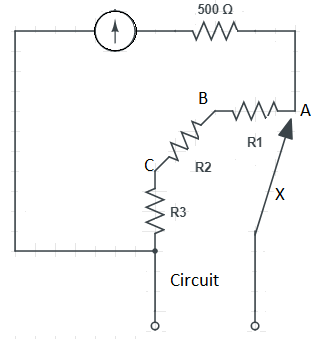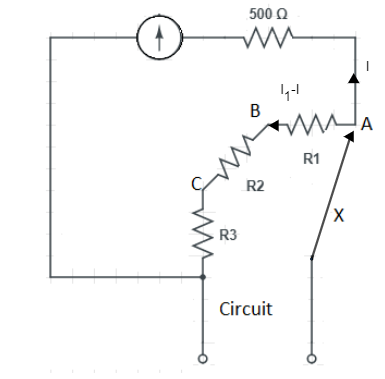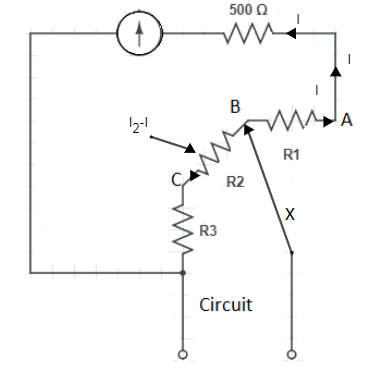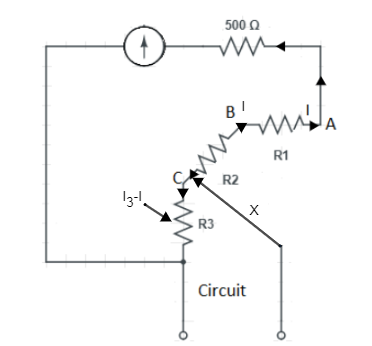Question
Question: A galvanometer is used to measure the small currents. A certain galvanometer has a resistance of 500...
A galvanometer is used to measure the small currents. A certain galvanometer has a resistance of 500Ω and gives a full scale deflection for a current of 200μA. This meter is connected as shown in the figure to make a multi range current meter. Connections to the circuit are made at the terminal shown. The currents in the external circuit needed to give full scale deflection when X is connected to A, B and C in turn is shown in the table.
| X connected to | Current in the external circuit (mA) |
|---|---|
| A | 1 |
| B | 10 |
| C | 100 |
Find out the of R3is

A. 2.25 Ω
B. 0.25 Ω
C. 1.25 Ω
D. 3.25Ω
Solution
In order to solve this question we have to use the Kirchhoff’s law for the give 3 conditions one by one which will give us combination of resistance by solving those equation we will get value of resistance R3.
Formula used:
V=IR
Complete step by step solution:
Now in order to get the solution we have to apply given 3 conditions one by one.
Given data:
R=500ΩI=200μA=200×10−6AI1=1mA=1×10−3AI2=10mA=10×10−3AI3=100mA=100×10−3
Now condition (i) when X is connected to A.

Now from the fig (i) let’s apply Kirchhoff’s law
500×I=(R1+R2+R3)×(I1−I)
Here all the three resistance are connected in the series therefore we can apply the series rule of the resistance.
Now let’s substitute all the values in the equation.
⇒500×200×10−6=(R1+R2+R3)×(1×10−3−200×10−6)⇒R1+R2+R3=0.8×10−3500×200×10−6⇒R1+R2+R3=0.810×104×10−6×103⇒R1+R2+R3=125∴R1+R2=125−R3....(1)
Now let’s apply the second condition:
When X is connected to the point B, circuit will becomes as shown in the figure (i)

Now let’s apply Kirchhoff’s law in the circuit shown in the figure (ii)
& \Rightarrow \left( 500+{{R}_{1}} \right)I=\left( {{R}_{2}}+{{R}_{3}} \right)\times \left( {{I}_{2}}-I \right) \\\ & \Rightarrow \left( 500+{{R}_{1}} \right)\times 200\times {{10}^{-6}}=\left( {{R}_{2}}+{{R}_{3}} \right)\times \left( 10\times {{10}^{-3}}-200\times {{10}^{-6}} \right) \\\ & \Rightarrow \left( 500+{{R}_{1}} \right)=\dfrac{\left( {{R}_{2}}+{{R}_{3}} \right)\times 9.8\times {{10}^{-3}}}{200\times {{10}^{-6}}} \\\ & \therefore \left( 500+{{R}_{1}} \right)=49\left( {{R}_{2}}+{{R}_{3}} \right)....\left( 2 \right) \\\ \end{aligned}$$ Now let’s apply third condition: When X is connected to the point C our circuit will be,  Now let’s apply Kirchhoff’s law on circuit shown in the figure (iii) $\begin{aligned} & \Rightarrow \left( 500+{{R}_{1}}+{{R}_{2}} \right)\times I={{R}_{3}}\times \left( {{I}_{3}}-I \right) \\\ & \Rightarrow \left( 500+{{R}_{1}}+{{R}_{2}} \right)\times 200\times {{10}^{-6}}={{R}_{3}}\left( 100\times {{10}^{-3}}-200\times {{10}^{-6}} \right) \\\ & \Rightarrow 500+{{R}_{1}}+{{R}_{2}}=\dfrac{{{R}_{3}}\times 99.8\times {{10}^{-3}}}{200\times {{10}^{-6}}} \\\ & \therefore 500+{{R}_{1}}+{{R}_{2}}={{R}_{3}}\times 499...\left( 3 \right) \\\ \end{aligned}$ Now from the equation (1) substitute value of the $\left( {{R}_{1}}+{{R}_{2}} \right)$ in the equation (3) $\begin{aligned} & \Rightarrow 500+125-{{R}_{3}}=499{{R}_{3}} \\\ & \Rightarrow 00{{R}_{3}}=625 \\\ & \therefore {{R}_{3}}=1.25\Omega \\\ \end{aligned}$ **Hence, the option (c) is correct.** **Note:** When we are dividing current be careful when putting $\left( {{I}_{1}}-I \right)$ or $\left( {{I}_{2}}-I \right)$ or $\left( {{I}_{3}}-I \right)$ it can be mistaken or misplaced as $\left( I-{{I}_{1}} \right)$ or $\left( I-{{I}_{2}} \right)$ or $\left( I-{{I}_{3}} \right)$ which can lead us to the wrong answer.